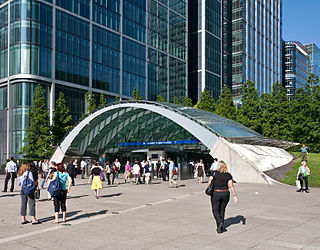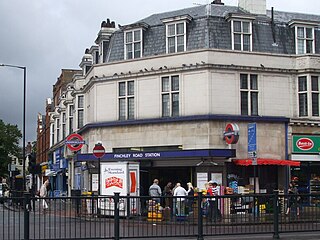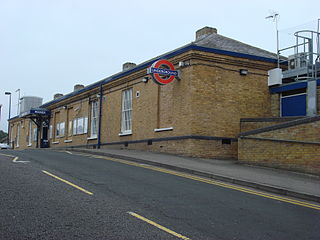
The Metropolitan line, colloquially known as the Met, is a London Underground line between Aldgate in the City of London and Amersham and Chesham in Buckinghamshire, with branches to Watford in Hertfordshire and Uxbridge in Hillingdon. Printed in magenta on the tube map, the line is 41.4 miles (66.7 km) in length and serves 34 stations. Between Aldgate and Finchley Road, the track is mostly in shallow "cut and cover" tunnels, apart from short sections at Barbican and Farringdon stations. The rest of the line is above ground, with a loading gauge of a similar size to those on main lines. Just under 94 million passenger journeys were made on the line in 2019.

The Bakerloo line is a London Underground line that runs from Harrow & Wealdstone in suburban north-west London to Elephant & Castle in south London, via the West End. Printed in brown on the Tube map, it serves 25 stations, 15 of which are underground, over 23.2 kilometres (14.4 mi). It runs partly on the surface and partly through deep-level tube tunnels.

The Jubilee line is a London Underground line that runs from Stanmore in suburban north-west London to Stratford in east London, via the Docklands, South Bank and West End. Opened in 1979, it is the newest line on the Underground network, although some sections of track date back to 1932 and some stations to 1879.

Waterloo is a London Underground station located beneath Waterloo National Rail station. As of 2023, it is the 2nd busiest station on the London Underground, with 70.33 million users. It is served by four lines: Bakerloo, Jubilee, Northern and Waterloo & City.

Dollis Hill is a London Underground station at Dollis Hill near to Willesden and Gladstone Park of the London Borough of Brent. It is on the Jubilee line, between Neasden and Willesden Green stations and is in Travelcard Zone 3. Metropolitan line trains pass through the station without stopping.

Baker Street is a London Underground station at the junction of Baker Street and the Marylebone Road in the City of Westminster. It is one of the original stations of the Metropolitan Railway (MR), the world's first underground railway, opened on 10 January 1863.

Canary Wharf is a London Underground station at Canary Wharf and is on the Jubilee line, between Canada Water and North Greenwich stations. The station is located in Travelcard Zone 2 and was opened on 17 September 1999 as part of the Jubilee Line Extension. Over 40 million people pass through the station each year, making it second busiest on the London Underground outside Central London after Stratford, and also the busiest that serves only a single line.

Kingsbury is a London Underground station in Kingsbury, north-west London, England. It is on the Jubilee line between Queensbury and Wembley Park stations, in Zone 4, in the borough of Brent.

Wembley Park is a London Underground station in Wembley Park, north-west London. It is served by the Jubilee and Metropolitan lines and is in Travelcard Zone 4. On the Jubilee line the station is between Kingsbury and Neasden stations, and on the Metropolitan line it is between Preston Road and Finchley Road stations. It is located on Bridge Road (A4089) and is the nearest Underground station to exit for Wembley Stadium and Wembley Arena. This is where the Jubilee line to Stanmore diverges from the Metropolitan line, which was formerly a branch of the Metropolitan Railway and was taken over by the Bakerloo line and is now part of the Jubilee line.

Neasden is a London Underground station in Neasden. It is on the Jubilee line, between Wembley Park and Dollis Hill stations. Metropolitan line trains pass through the station but do not stop. The Chiltern Main Line/London to Aylesbury Line runs to the west of the station.

Kilburn is a London Underground station near Brondesbury Park in north-west London. It is on the Jubilee line, between Willesden Green and West Hampstead stations and is in Travelcard Zone 2. The station is on the A5 Kilburn High Road or Shoot-up Hill, approximately 0.1 miles (0.16 km) north of Brondesbury station. Metropolitan line trains typically bypass the station without stopping.

West Hampstead is a London Underground station in West Hampstead. It is located on West End Lane between Broadhurst Gardens and Blackburn Road and is situated in Travelcard Zone 2. It is on the Jubilee line between Kilburn and Finchley Road stations. It is 100 m (110 yd) from West Hampstead station on the London Overground Mildmay line and 200 m (220 yd) from West Hampstead Thameslink station. Metropolitan line trains also pass through the station, but do not stop.

Finchley Road is a London Underground station at the corner of Finchley Road and Canfield Gardens in the London Borough of Camden, north London. It is served by the Jubilee and Metropolitan lines and is located in Travelcard Zone 2. On the Jubilee line, the station is between West Hampstead and Swiss Cottage stations. On the Metropolitan line, it is between Wembley Park and Baker Street stations.

Swiss Cottage is a London Underground station at Swiss Cottage, north London. It was opened in 1939 as a stop on the Bakerloo line. Today, the station is on the Jubilee line between Finchley Road and St John's Wood stations. It lies in Travelcard Zone 2 and is located at the junction of Finchley Road, Avenue Road and College Crescent. The station is a local station, with the Metropolitan Line bypassing the station nearby.

St. John's Wood is a London Underground station located in St John's Wood in the City of Westminster, north-west London. It was opened in 1939 as a stop on the Bakerloo line. Today, the station is on the Jubilee line between Swiss Cottage and Baker Street stations and is in Travelcard Zone 2. Essentially, St. John's Wood station is a local station with the nearby Metropolitan Line bypassing this station. A Jubilee line journey between St. John's Wood and Baker Street typically takes less than three minutes.

Canons Park is a London Underground station at Canons Park of the London Borough of Harrow, north-west London. It is on the Jubilee line, between Stanmore and Queensbury stations and is in Travelcard Zone 5. It is also the least used station on the Jubilee line with an average of 1.68 million passengers per year.

Stanmore is a London Underground station in Stanmore, north-west London. It is the northern terminus of the Jubilee line and the next station towards south is Canons Park. The station is on the south side of London Road and is in Travelcard Zone 5.

Willesden Junction is an interchange station located in Harlesden, north-west London. It is situated on the Bakerloo line of the London Underground and the Lioness and Mildmay lines of the London Overground. The station is located close to the Old Oak Lane conservation area in the East Acton ward.

Harrow & Wealdstone is an interchange station located in Harrow and Wealdstone in the London Borough of Harrow. It is situated on the Bakerloo line of the London Underground, of which it is the northern terminus; the Lioness line of the London Overground; and on the West Coast main line (WCML) for National Rail services operated by London Northwestern Railway and Southern.

Pinner is a London Underground station in Pinner, north-west London. The station was opened in 1885 as part of the Victorian expansion of dormitory suburbs, and was one of the stations included in the Metro-land project in the early 20th century. The site is served by several bus routes including links to the Hatch End railway station which was known as Pinner & Hatch End prior to 1920. Step free facilities were opened in 2008. The station is on the Metropolitan line between Northwood Hills and North Harrow stations, and is in Travelcard Zone 5.


































